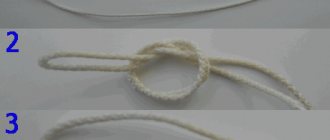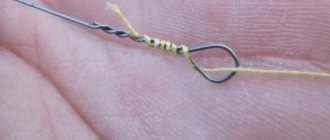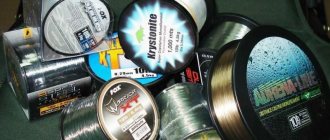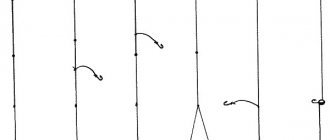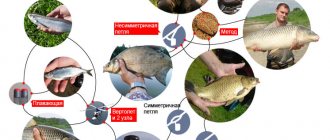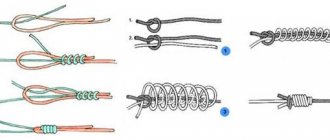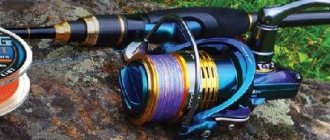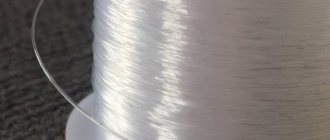Published: 08/19/2016 23:54
Braided fishing line is significantly superior to monofilament in strength, which is what captivates anglers. In matters of feeder fishing, the almost zero stretchability of the braid is also important. But can braided material completely replace monofilament? The answer may seem strange to an inexperienced fisherman, but the verdict will be the same - no!
Braid and monofilament have their own strengths and weaknesses and are used in different conditions, so they do not exclude, but complement each other. In what conditions is monofilament used and how to choose a fishing line for feeder fishing, we will look below.
In what cases is it preferable to use monofilament fishing line?
Monofilament fishing line is used for fishing at short and medium distances in reservoirs without a pronounced water current. Since we are not talking about fishing at ultra-long distances and in strong currents, the advantages of thin braid are unclaimed, but high-quality monofilament line:
• cheaper than branded braid; • better resists abrasion from hard vegetation, snags and shells; • thanks to the small stretch coefficient, it “knits” fish better, not being inferior to braided line in sensitivity; • forgives some of the fisherman's mistakes.
Monofilament fishing line is also used on rivers with a current, in cases where the casting range is small and the bottom is covered with “evil” shells. For long casting distances, monofilament has greater resistance to water flow than braided line, so only a fishing line insert is used - a shock leader.
Monofilament fishing line is also used when fishing for carp with a feeder on commercial reservoirs using flat feeders. In this case, the stretchability of the fishing line is its advantage, since it allows you to dampen the jerks of the fish, and sensitivity in carp fishing is not even a minor factor. To be fair, it is worth noting that the feeder is used when catching small “tuzik” carp weighing up to three kilograms. In trophy fishing, it is preferable to use special carp rods.
Rating of the best manufacturers
Feeder line is not the main product of manufacturers doing business in this sector, but there are companies that adequately fill this niche with specific types of line suitable for the conditions of this type of fishing. Based on the adequacy of price and quality parameters, we will try to give recommendations for purchasing a product of this type by compiling a rating of manufacturing companies.
Shimano
Among the many companies, what stands out is a product developed and already quite widely introduced into the field of feeder fishing from the Shimano brand. I would like to note that the feeder lines of this company are quite expensive, but at the same time they are durable in their operation. Compared to similar representatives of other offers, this accessory will last three or even four times longer. Shimano Technium and Shimano Technium Tribal cover the angler's needs for a monofeeder cord and a variety of colors and diameter variations. The rigidity of the fishing line is close to the rigidity of a braided cord and, under certain conditions, these fishing lines provide fishing opportunities at longer distances.
Suffix
Suffix offers the consumer cheaper cord options, but they are quite suitable for feeder conditions. It's definitely worth paying attention to Sufix Specialist Carp. This monk has a low elongation coefficient and high abrasion resistance. Having purchased a reel of 300 meters, the angler will remain closed on the accessory per rod for two full seasons. The range of diameters is also not without variety. Multiples of 0.05 mm are available.
Trabucco
Trabucco stands out for its cheapest options for feeder-oriented monofilaments, which cannot but please the angler. But when purchasing a product, you need to be careful when selecting the diameter and always check this parameter visually, or even using a measuring tool. The company often makes mistakes in accurately marking the fishing line and can easily overestimate this indicator. Otherwise, average rigidity parameters and weak memory provide good opportunities for using the accessory in fishing practice. The Trabucco T-force feeder, with a volume of one hundred meters or more, will cover the intensive fishing season on the sandy and muddy bottoms of the reservoir quite well.
Owner
Owner offers monofilament lines for extremely short distances. The brand Owner Broad and Owner Broad Carp and its winding from one hundred to three hundred meters are more suitable cord bases for the feeder. The advantages are low curling and wear resistance, and the price is pleasing with its low performance. But the high elongation negates the use at longer distances, and over twenty meters the sensitivity of the gear is lost several times.
Mikado
Well, the Mikado . Feeder monks of its production with high rigidity, low windage and low memory cover the fishing conditions in reservoirs with moderate and medium currents. The price parameters are in the budget comfort zone, but the manufacturer is clearly not worried about the range of diameters. Alternating diameters every 0.5 mm cannot satisfy the need for some specific conditions of fishing parameters. The Mikado Sensei Feeder in black is especially recommended by experts for use in feeder fishing sessions.
Every fisherman who is interested in this method can determine the best lines for a feeder based on personal experience and their practical application.
How to choose a fishing line for a feeder
You should not equip your feeder reel with cheap fishing line from an unknown manufacturer. In addition to the worse breaking load characteristics compared to high-quality fishing line, such fishing line often has greater elongation, and what’s even worse - it has “memory”, i.e. retains the resulting deformation after eliminating the source of the deformation.
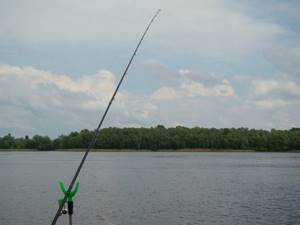
World-famous fishing line manufacturers do not ignore the issues of feeder fishing, and develop fishing line adapted specifically for feeder fishing. By the way, match fishing lines for the most part are excellent for feeder fishing. Their main feature is their greater specific gravity, which allows the equipment and the line itself to sink into the water faster, which in no way interferes with their use in feeder fishing.
An excellent example of specialized feeder lines are the Feeder Line and Ultron Feeder Pro from the Japanese company Momoi. Both fishing lines have low stretch, which at short and medium distances allows you to record careful bites no worse than when using braid. But this slight stretchability has a positive effect on fishing and partially dampens the jerking of the fish. The lack of memory and sufficient rigidity of the fishing line allows you to knit loop rigs directly on the main fishing line, and in case of fishing on a soft bottom, these rigs can be used for several fishing trips.
The Ultron Match Fishing line has also proven itself to be excellent on feeder gear . Unlike those described above, it is less rigid, which has a positive effect on casting distance. This fishing line is slightly inferior to Ultron Feeder Pro in strength, which is due to the specifics of the production of sinking fishing line.
If we talk about wide-profile fishing lines, then such fishing lines can be used in feeder fishing as Ultron Zex Copolymer and Ultron Elite Platinum . A distinctive feature of the latter is its softness, which helps to increase casting distance. If in-line installation is used, it can be formed on the main fishing line, but for loop installations an insert made of a stiffer fishing line will be required.
You can’t ignore the specialized fishing line for the Momoi Shock . The shock leader bears the brunt of dealing with the sharp edges of stones and shells, so it must have increased resistance to abrasive damage. Momoi Shock Leader line is used with both thinner monofilament line and braided line. It is also possible to use feeder lines as a shock leader, but their diameter should be forty percent larger than that of the main line.
Another task of the shock leader is to work when casting heavy equipment, when it is the shock leader that takes on the impulse load of the cast, and then simply pulls out the thinner main line. The length of the shock leader must be at least twice the length of the rod.
Top 5 leader lines. 2021 version
But what they say is true is that the choice of hooks and leading line is a purely individual matter and, one might say, almost “intimate”. This is for a braided cord or monofilament used as the main line, the criteria are clearly defined and almost one hundred percent of models from more or less famous manufacturers meet them - just take it and use it! With leader lines, the situation is different - even the same ones, according to manufacturers, can be strikingly different from each other in terms of performance. Here you have to rely not only on your own feelings, but also look into various cheat sheets, which can be our top today.
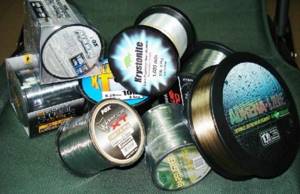
What characteristics should high-quality leader lines have?
The list here is quite extensive:
• Exact correspondence between the actual and declared diameters; • Quite a high degree of elongation, which has a positive effect on shock absorption; • Ability to “hold” a knot – minimal decrease in strength on it; • Resistance to ultraviolet radiation, direct sunlight and moisture; • “Softness” – the leading line should feel soft and not arouse suspicion in the fish;
As you can see, there are many criteria separating truly high-quality fishing lines from mediocre ones. It is for this reason, in order not to turn into a blind kitten and not to pick up fishing line by touching all the options on the market, it is best to purchase one of the options offered in this list.
What leash lines can I recommend for purchase?
Team Salmo Tournament
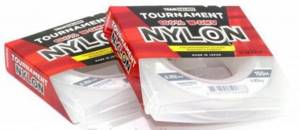
A high-quality fishing line created by the manufacturer specifically for use in harsh competitive fishing conditions and passed numerous tests by sports anglers. It is characterized by high elasticity and wear resistance, the loss of strength at the node does not exceed 7%. Widely used in float and feeder fishing, as well as during ice fishing. Available in diameters from 0.083 to 0.223 millimeters. The approximate price tag is about 4.2 dollars.
Colmic Xilo
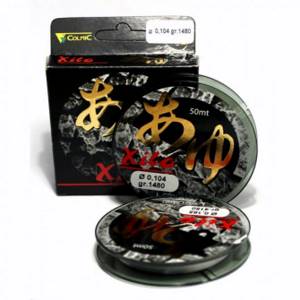
A timeless classic from Colmic, chosen by many sports anglers. It is characterized by the highest quality workmanship, precisely calibrated diameter along the length and full compliance with real and declared values, and high abrasive resistance. Disadvantages include finicky storage and a tendency to decrease strength over time - “old” fishing line loses a significant percentage of its strength, and therefore the closest attention should be paid to the production date. Available in diameters from 0.053 to 0.25 millimeters, the retail price is about $7.
Trabucco XPS Match Strong
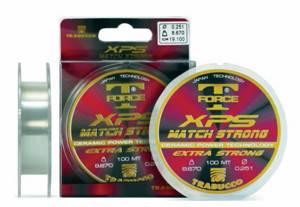
Our rating won't do without Trabucco. This manufacturer is most often positioned as a “float”, which, however, does not prevent the use of its gear and accessories for other fishing methods. XPS Match Strong is a high-quality monofilament line, characterized by increased strength with a low diameter. The latter undergoes careful calibration and exactly corresponds to the values declared by the manufacturers. The knot “holds” perfectly – the loss of strength does not exceed five percent. Available in unwinds from 0.08 to 0.2 millimeters, the approximate price tag is $4.5 for a 50-meter unwind.
Colmic Mimetix
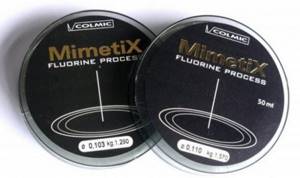
Another option from Colmic, this time more “feeder” than Xilo. The reason for this is increased rigidity, which has a positive effect on the leash getting tangled and twisted when reeling out the tackle - the leash lives much longer compared to soft fishing lines. It is also distinguished by a high degree of calibration and compliance with the actual and declared diameter. It is produced in 50-meter markings, and the list of diameters available to anglers starts from 0.071 mm and ends with 0.22 millimeters. Approximate price tag – 7 dollars.
Owner Broad
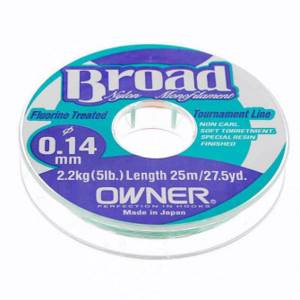
A time-tested line that has been popular among anglers for more than five years. It is one of the first near-sports models that can withstand intensive use. It is characterized by increased softness, high strength and minimal visibility in water. The knot holds quite well - losses do not exceed 7-8%. The disadvantages include a slightly underestimated diameter relative to real values. This should be remembered when choosing. It is produced in both fifty- and one hundred-meter unwinds, the list of diameters includes both leader models and fishing lines, which can easily be used as main or shock leader. The approximate price tag is about 6.5 dollars.
Line diameter for feeder
The peculiarity of feeder fishing is that the diameter of the fishing line, and in other words, its breaking load, is determined not in accordance with the weight of the expected trophy, but in accordance with operational requirements. The only exception is carp fishing with heavy feeders, but this is no longer a classic feeder, but its adaptation for carp fishing.
By the concept of operational requirements we mean the ability of the fishing line to withstand peak loads when casting equipment of a certain weight over a given distance and the ability to tear the feeder off the bottom when fishing on a steep slope. The first part of the issue is solved by using a shock leader, the second - only by using a fishing line with a sufficient margin of safety.
Let's move on to the numbers. For fishing with a picker or a light feeder on a clean, flat bottom with a casting distance of up to 25-30 meters and using feeders weighing up to 30 grams, a high-quality fishing line with a diameter of 0.15 millimeters will be sufficient. If you increase the casting distance to 40 meters and the weight of the feeder to 40 grams, you will need a fishing line with a diameter of 0.18 millimeters. But this is only in the case of fishing on lakes and rivers without “evil” edges and dumps. Otherwise, the minimum diameter will be 0.22 millimeters. In addition to increasing the breaking load in this version, increasing the diameter of the fishing line also provides greater resistance of the fishing line to cutting and abrasion at the edge.
For fishing on large bodies of water, where you need to cast a heavy feeder weighing 60-80 grams, you will need a fishing line with a diameter of 0.25 millimeters. When the weight of the feeder increases by more than 100 grams, the diameter of the fishing line needs to be increased to 0.28-0.3 millimeters, but in this case we are talking about a shock leader, since in such conditions monofilament fishing line is practically not used as the main one, giving way to braided fishing line fishing line
As we can see from the above, to equip a picker and a light feeder you will need a fishing line with a cross-section of 0.15-0.18 millimeters, and the most optimal for a medium and medium-heavy class feeder will be a fishing line with a cross-section of 0.22-0.25 millimeters.
Heavy river feeders are equipped with braided line with a monofilament or fluorocarbon shock leader with a diameter of up to 0.32-0.35 millimeters, and when fishing for carp, the breaking load of the fishing line is determined in accordance with the weight of the expected trophy.
Since increasing the thickness of the fishing line negatively affects the sensitivity of the gear, you should not get carried away with an excessive safety margin. Feeder reels are equipped with two spools, which allows you to wind fishing line of different diameters on both spools and use them depending on the situation. Moreover, additional spools are sold separately for branded reels, which further expands the angler’s capabilities.
The best monofilament lines
Daiwa Ginro Silver Beast Nanodis
Rating 4.9
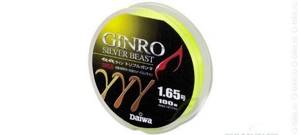
Daiwa Ginro Silver Beast Nanodis can be considered a leader in the quality-to-price ratio component. Daiwa loves to experiment with various aspects of its equipment, but this series was presented as a focused, non-distracted creation designed to improve fishing performance during the summer season.
Monofilament fishing line is characterized by a very high breaking load (up to 5.4 kilograms), which is achieved through precise calibration of the diameter along the entire length. It holds the knot well and, as the manufacturers assure, has virtually no memory effect. The latter, however, was refuted by the fishermen themselves - total bends do not appear on the monofilament, but it remembers the outlines of the accepted shape well. The main types of bait that are ideally combined with the Ginro Silver Beast Nanodis are wobblers (to a lesser extent), tails and spinners.
Advantages
- high values of breaking loads (for fishing line with a diameter of 0.285 mm - 5.4 kg);
- precise calibration throughout the entire unwinding;
- high catchability (mainly trout);
- characteristic yellow color, merging with water.
Flaws
- the presence of a weak memory effect.
Line for leashes
The leash is the weakest part of the feeder equipment. Adding a certain margin of safety by increasing the diameter of the leash often results in a weakening or complete cessation of the bite, so this method is ineffective. There is only one thing left to do - make leashes from high-quality fishing line and change them periodically, especially if fishing is carried out on stones, shells or among hard vegetation.
Some of the best fishing lines for making leashes are winter fishing lines from Momoi. Why winter ones? The fact is that in addition to the ability to work at low temperatures, winter fishing lines stretch well, which gives the leash shock-absorbing properties. A good example is Ultron Elite Platinum and Pro-Max Prestige in 30-meter rolls. Fluorocarbon fishing lines are also worthy of attention. They are more resistant to abrasion, which is important when fishing from the bottom. In addition, the refractive index of light in fluorocarbon (fluorocarbon) and in water is almost the same, which makes this fishing line less noticeable to water. In the Momoi line of fishing lines, this type is represented by winter fishing lines Ultron Fluorocarbon and Pro-Max Flurocarbon in 25-meter reels.
In general, other fishing lines from Momoi or other manufacturers can be used to make leashes. The angler chooses the color of the fishing line, its diameter and stiffness based on the fishing conditions and the required characteristics, but the leading line must:
• have high breaking load values; • do not lose strength at the nodes; • have no memory; • be inconspicuous in water or against the background of the bottom of a reservoir (depending on conditions).
The positive qualities of monofilament fishing line include
Throwing light baits over long distances is done with high quality, due to the low coefficient of friction (it glides better along the guide rings). If we compare it with different types of fishing line, there is no significant difference (in terms of strength). Comparing monofilament with a diameter of 0.20 mm and a braided cord with a thickness of 0.12 mm, the monofilament wins in terms of casting range.
But provided that all possible wobblers, rotating spinners with a core, as well as a lightweight version of thin spinners are used as bait. But the use of baits weighing 10 grams equalizes the performance characteristics of monofilament and braided line.
The use of weighty baits works well in combination with braided cord. For example, a bait weighing 20 grams on a cord with a diameter of 0.15 mm allows you to cast ten meters further relative to a monofilament line with a thickness of 0.25 mm, although their breaking parameters are practically the same.
It has little resistance in the water column, which greatly simplifies the process of placing light bait at the required depth. Then, a braided cord with a higher resistance and at a high speed of wiring helps push the light bait to the surface of the water.
By increasing the weight, the difference between fishing threads decreases, and by using lightweight versions (up to 5 grams) of baits, the differences become more noticeable. There is an opinion among fishermen that braided line is noisier in the water than monofilament, and this negatively affects the fishing process (scares away predators).
In some situations, to hunt the most sophisticated predator, you have to use the most invisible fishing line in the water, but if there is a need to monitor the fishing line, it is recommended to use a fluorescent option. All these varieties are considered only in the monofilament category, and braided cord will not work here.
A simple inertial reel and monofilament line completely complement each other - due to its stretchability, monofilament is able to dampen aggressive jerks at the time of fishing and reduce the load on the tackle. If the rod is equipped with a more modern reel, then this function falls on the friction brake (if the product is correctly configured).
Depending on the fishing conditions, monofilament can be visible, invisible to the eyes of potential prey. Endowed with stretchability, which helps reduce aggressive jerking of trophy specimens.
It has an affordable price, which has a positive effect on the choice of gear and its components: a simple rod, a regular reel.
What should a leash be like?
As mentioned above, an excessively thick leash can stop the bite. Therefore, you should use a leash of minimum thickness with the minimum breaking load allowed under specific fishing conditions. The thickness of the leash, as in the case of the main line, is chosen not so much from the weight of the trophy, but from the fishing conditions.
When catching small bream, silver bream and roach on a clean bottom, a leash with a cross-section of 0.1-0.11 millimeters is sufficient. Since a feeder rod, when fished skillfully, dampens the jerks of the fish, in a clean area of the reservoir with such a leash you can defeat even a kilogram bream. Sometimes, when large fish bite capriciously, you have to use this tactic, but for targeted catching of bream it is better to increase the diameter of the leader to 0.12-0.14 millimeters.
But it was not for nothing that the clause about a clean day was made! A leash with a cross-section of 0.1 millimeters is instantly cut by grass and shells, leaving the angler with no chance to realize a bite. Therefore, when fishing on the edge, it is not advisable to use a leash thinner than 0.12 millimeters. The next point is the thickets of grass in the coastal zone. On a leash of 0.12, you can confidently bring a three-hundred-gram bream out of the depths, but already near the shore it gets stuck in a carpet of aquatic vegetation, from which it is no longer possible to remove it on a thin leash. It is for this reason that in the summer it is necessary to install leashes up to 0.18 millimeters in cross-section, although catching large fish is not predicted.
Based on the above, we conclude that for feeder fishing you will need leashes with a cross-section from 0.1 to 0.18 millimeters. Thicker leashes are needed only when purposefully catching large fish and their breaking load is determined by the weight of the intended trophy.
How to tie a fishing hook correctly
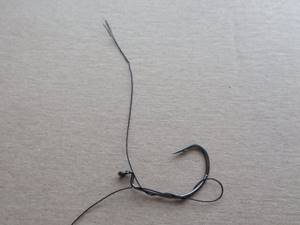
There are many knots for tying hooks, but as practice shows, there is no particular need to know them all. It is enough to master the one given below - the most universal and reliable knot, which in the fishing circle is called “universal”. With its help you can tie any hook, whether it has a ring or a spatula - it doesn’t matter. In order to tie a hook (a large offset one is taken in the photo for better visualization) with this knot, you need to fold the leader line in half (Fig. 1) and, holding the hook with two fingers by prying it, press the open loop of the folded line with the pad of your thumb. Next, the free end of the fishing line in the direction from the back of the hook to the shank is wrapped around the hook and the fishing line located along it (Fig. 2,3).
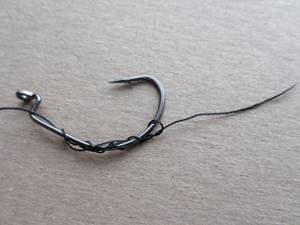
A total of 7-8 turns are performed, after which the free end of the fishing line is inserted into the loop (Fig. 4), which was pressed with the pad of the finger. Next, by alternately pulling both ends of the fishing line, the knot is tightened and shifted to the ring or blade (Fig. 5). Before final tightening of the knot, it must be moistened (usually with saliva), which will ensure better tightening of the knot and reduce chafing of the line. After tightening, the free end of the fishing line is cut so that a tail of about 2 millimeters remains. That's it, the hook is attached.
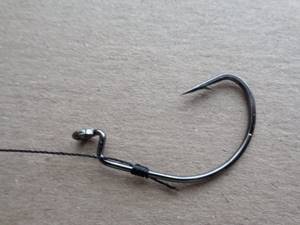
How to attach a leash to a rig
In feeder fishing, a simple and reliable method of attaching leashes “loop to loop” is used (Fig. 6). To do this, a loop is formed on the main line and at the end of the leash, which is knitted with a triple knot (Fig. 7). The loop is knitted as follows: the fishing line is folded in half (Fig. 8), an open loop is formed with the double end (Fig. 9), after which it wraps around one arm of the loop three times (Fig. 10). The knot is wetted and tightened. The free tip is carefully trimmed (Fig. 11).
Now, to connect the leash, it is enough to thread the loop of the leash into the loop of the main fishing line (Fig. 12), and then thread the hook into the loop of the leash and pull the entire leash through this loop (Fig. 13). After tensioning, we obtain a finished connection (Fig. 14), which is the loose fastening shown in Fig. 6. By performing the operation in the reverse order, it is easy to remove the leash from the equipment.
